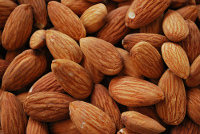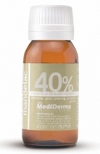Mandelic acid
Mandelic acid:
 - in natural conditions it occurs in bitter almonds, apricots, and wild cherries,
- in natural conditions it occurs in bitter almonds, apricots, and wild cherries,
- as it has very large molecules, it penetrates the skin slowly,
- has lipophilic properties, and so it operates within the sebaceous glands,
- has anti-inflammatory action,
- carries no risk of skin sensitization to the sunlight - may be therefore applied throughout the whole year,
- has short heeling period, does not cause skin irritation, gives minimal skin redness and mild flaking after the treatment - does not interrupt in daily activities,
- is safe for patients with dark skin phototypes,
- disadvantages: effective only in less intensive skin conditions;
Indications for mandelic peel:
- pigmentation disorders: melasma, post-inflammatory hyperpigmentation (e.g. acne), freckles, lentigines,
- treatment of acne and seborrhoea,
- recommended in case of sensitive skins prone to acne rosacea and telangiectasia;
 Mandelac - dermatological, superficial peeling based on mandelic acid. The mandelic acid molecule is larger than the glycolic acid molecule, and as an acid, mandelic acid is stronger than glycolic acid. Chemically, mandelic acid has a structure similar to antibiotics and so it is appreciated for its well-established disinfecting and antibacterial activity. It gives exfoliating effect, regulates sebum secretion and thanks to these properties is applied in therapies of moderate acne and recommended for skin care in patients with mixed and seborrheic skin.
Mandelac - dermatological, superficial peeling based on mandelic acid. The mandelic acid molecule is larger than the glycolic acid molecule, and as an acid, mandelic acid is stronger than glycolic acid. Chemically, mandelic acid has a structure similar to antibiotics and so it is appreciated for its well-established disinfecting and antibacterial activity. It gives exfoliating effect, regulates sebum secretion and thanks to these properties is applied in therapies of moderate acne and recommended for skin care in patients with mixed and seborrheic skin.

